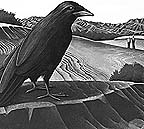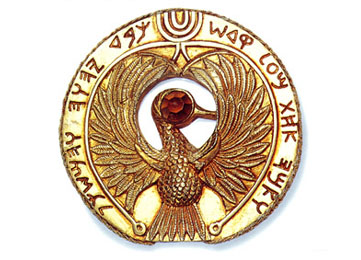
Clement Meighan was one of the first archaeologists to develop chronologies and assess cultural development in western Mexico and California. He also did archaeological work in Chile. He was a prime motivator in the modern day development of UCLA's Department of Anthropology. He founded the Rock Art Archive and was the first director of the archaeological survey, which today is known as the South Central Coastal Information Center.
Meighan was born on Jan. 21, 1925 in San Francisco and died April 30, 1997 in Bend, Oregon. He was married to Joan Seibert and had one daughter, Maeve. He earned his Bachelors Degree from the University of California, Berkeley in 1949 and his Ph.D. from the University of California, Berkeley in 1953. In 1952, Meighan began working for UCLA and in 1962, he became a professor. Meighan was a Fellow of the American Anthropological Association and the American Geographical Society.
In the Spring of 1962 Meighan joined an expedition funded by mystery writer Erle Stanley Gardner, the creator of Perry Mason, to record the then recently rediscovered rock shelter paintings in Baja California. They explored four rock shelters on foot and took photographs of five others from a helicopter. Photographs of the paintings appeared in an article by Gardner in Life Magazine and in his book The Hidden Heart of Mexico, both published that year. In 1966, Meighan published an account of the paintings along with information regarding a few artifacts found at the sites in American Antiquity.
Well before that 1962 expedition to Baja Meighan had already developed a long history with Mexico. Just after high school, at age 17, facing the draft the next year, Meighan decided to broaden his perspective of the world by traveling in Mexico for a time before going off to war. On that trip the young Meighan met a man who may have had an infulence guiding him toward future endeavors.
The following are two brief excerpts written by the nephew of the man Meighan met on his travels. The nephew's uncle, an artist, had been invited by the famed Mexican muralist Diego Rivera to visit him in Mexico:
"The following year, 1942, even though Pearl Harbor had just been bombed a few months before and war had broken out all across the Pacific and in Europe, my uncle honored his invite by Rivera. In those days my uncle lived hand-to-mouth, project to project, one painting to the next. So said, on his trip to Mexico he went by train traveling 4th class. Fourth class was usually filled with the indiginous poor, baggage, and sometimes even animals. My uncle had traveled in Mexico several times by train but very sledom did he ever see other white Americans traveling less than 2nd class. However, on this trip and highly unusual, there was a young boy, quite clearly an American and appearing to be in his mid-teens or so, traveling in 4th class unaccompanied by any adults or family. Although the boy projected a certain strength in confidence he seemed somewhat uncomfortable in what was most likely unfamiliar surroundings. Inturn, my uncle started up a conversation with him. The boy turned out to be a young Clement Meighan, recently graduated from high school (early), age 17 and traveling in Mexico on his own just to learn and for the experience before what he saw as the impending draft into the military the next year when he turned 18.
"On the train with the young Meighan my uncle soon learned that the boy had an avid interest in bugs and insects. Now, my uncle was not particularly versed in bugs and insects per se' but, because of his ever-growing interest as a bio-searcher he was continually coming in contact with a huge variety of bugs, so he thought he had enough of a working knowledge to discuss them at least at the same level as the 17 year old Meighan. He soon found out such was not the case. Covering his thinly veiled knowledge of insects my uncle reminded Meighan there was a whole lot more to the desert and the desert southwest than bugs. It was full of all kinds of plants and animals, fossils, ancient ruins and archaeological sites, mystical and spritual places and deep secrets." (source)
It should be noted that the following year, at age 18, Meighan was indeed drafted. In July 1944 during the battle for Saipan he was wounded by machine gun fire and evacuated. From the evacuation point, according to Meighan's friend Brian D. Dillon, himself a well respected colleague in the field, the following is what transpired:
"Triage doctors concluded he would not survive the night and not worth the trouble of operating on. Meighan was covered with his poncho and placed among the dead. But, it rained that night, reviving him, and in the morning when an orderly came to the field hospital with the news that there was space for one more casualty on the evacuation plane to Hawaii, Meighan threw off his poncho, literally rising from the dead, and ended up being the last wounded man put on the plane. Still only clinging to life, he celebrated his 20th birthday in the hospital in Honolulu."
Although having a full and varied life and an exceptional academic career, in an off-hand sort of way Meighan is infamous for being the person that first introduced Carlos Castaneda to Shamanism. Matter of fact, Castaneda felt so strongly toward Meighan's contributions that he opened his first book, THE TEACHING OF DON JUAN:, A Yaqui Way of Knowledge, with an acknowledgement toward his professor that reads thus:
"I wish to express profound gratitude to Professor Clement Meighan, who started and set the course of my anthropological fieldwork."
The relationship all started when Castaneda, as a fledging undergraduate student at UCLA, took a class from Meighan during the spring semester of 1960 titled "Methods in Field Archaeology." A class assignment led to the infamous Castaneda's 1960s Paper on Datura. The class also led to Castaneda going on a Road Trip throughout the desert southwest in search of medicinal and spritual plants. The final result of that road trip setting the scene for the meeting between Castaneda and Don Juan Matus, the shaman/sorcerer said to have studied under a Diablero --- a sorcerer with evil powers said to have the ability to shape shift. The outcome of that meeting made both the Shaman and Castandea famous in the series of Don Juan books --- and Castaneda incredibly rich. Castaneda wrote about using a plant called Sacred Datura in a spiritual rite that sent him into other worlds of consciousness. The following, as found in the 1996 book A Magical Journey With Carlos Castaneda, by Castaneda's ex-wife, Margaret Runyan, Meighan is quoted by Runyan as saying:
"His informant knew a great deal about Datura, which was a drug used in initiating ceremonies by some California groups, but had presumed by me and I think most other anthropologists to have passed out of the picture 40 or 50 years ago." (source)
Professors, anthropologists, and archaeologists, like Meighan, contributing to or influencing Carlos Castaneda:
Books by Clement Meighan are:
- The Maru Cult of the Pomo Indians 1972
- The Archaeology of Amapa, Nayarit 1977
- Prehistoric Trails of Atacama 1980
Resources
Who's Who in America. 45th edition. Vol. 2. Marquis Who's Who. 1988.
 |
THE BEST OF CARLOS CASTANEDA |
| <<< PREV ---- LIST ---- NEXT >>> | |

|